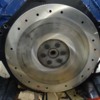What I have seen on flywheel wear, that is pretty much a normal appearance of a running flywheel.
IF you can catch a finger nail anywhere on the flywheel you have more of an argument to resurface it again.
When we say, "there is a break in period for the clutch", what the clutch disc is doing is setting a pattern into the flywheel by wearing a pattern like that into the flywheel. It is "fine fitting" the surface of the disc to the assembly.
At that point you are looking at, it is slipping ever so slightly at 98% of full engagement. That doesn't matter much UNLESS you were attempting to "drop the clutch" while drag racing it. Then it will get worse and depending on the lining material you selected simply because it hasn't fully seated itself yet for maximum friction.
There with maximum traction and maximum engine torque you are just going to overwhelm the clamping ability and it will slip.
With any kind of a hard lining like a Centerforce dual friction, it takes easily 1,200 to 1,500 miles to get it to work right. The components need to wear themselves together. You WILL see shiny spots and areas void of that. That has to do with the ability of the pressure plate to apply perfectly equal loading pressure to the disc and apparently that is next to impossible?
What you are showing in that picture is not a slipping clutch in my view. It's more of a "chalking" effect that impurities in the clutch lining and possibly additives to the engine oil that has leaked have caused.
I would change the clutch lining, clean up the pressure plate with about an 80 grit sandpaper.
It certainly won't hurt to resurface it again but you just don't need it. Look at the brass rivets on the disc. If they show scuffing, wear, polished at all, even on, replace it.
Those things tend not to absorb oil into the lining but there is no guarantee that they won't hold spots or pools of oil that will interfere with the grabbing ability of the lining.
The organic materials of "standard" discs are the best at recovering from getting doused with oil and linings like the "dual friction" are the worst because one side is so metallic.
The flywheel side is the "hard side" and oiling that is like oiling a bearing.
On my dual friction clutches you can actually catch your finger nail on the flywheel where the disc is cutting itself into the flywheel. It actually grabs better on an iron flywheel rather then the forged steel flywheel.
Everyone is going to have different perspectives on why and how these things work. These are just my observations of 40 some odd years of my experiences and mistakes.
I think you learn more from the mistakes made. I suppose that means for me, learning never ends?



